Best fish tank decorations 2025: Turn your home aquarium into an eye-catching centerpiece
The best fish tank decorations create a stimulating environment for your finned friends
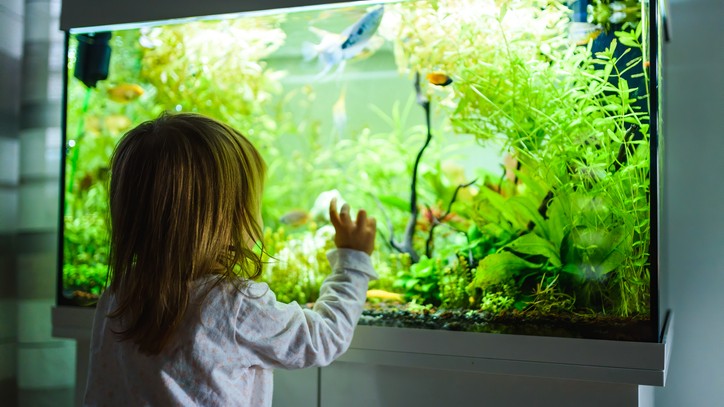
With the best fish tank decorations and accessories, you can create both a stimulating environment for your pet swimmers and a wonderful talking point for your home. To that end, it’s worthwhile taking a step back and considering what would work well in the tank. You’re certainly not short on options.
There are lots of accessories in every shape, size and color imaginable as well as some important, sensible items. You should invest in a thermometer, for example, but you should also ensure your tank includes stones and rocks, which offer a lovely natural look and mimic a fish’s natural environment.
Caves, ships, and ruins are a fun addition that will provide your fish with plenty of places to explore. Driftwood is a popular choice too. Even if you own one of the best small fish tanks, you need to add something and one or two decorations are better than none. “A bare tank will not only affect the mental well-being of your fish but will also be pretty boring for you to look at,” says our expert vet Dr Rebecca MacMillan.
Join us then as we take a look at the best fish tank decorations and accessories. We’ll examine options that would work well in the larger best tropical fish tanks as well as those suitable for smaller environments. And if you want your fishes to truly stand out, consider the best fish tank stand you can afford as well, to make your aquarium a true, stylish visual centrepiece in your home. Let’s catch them all.
PetsRadar's pick of the best fish tank decorations 2025
Why you can trust PetsRadar
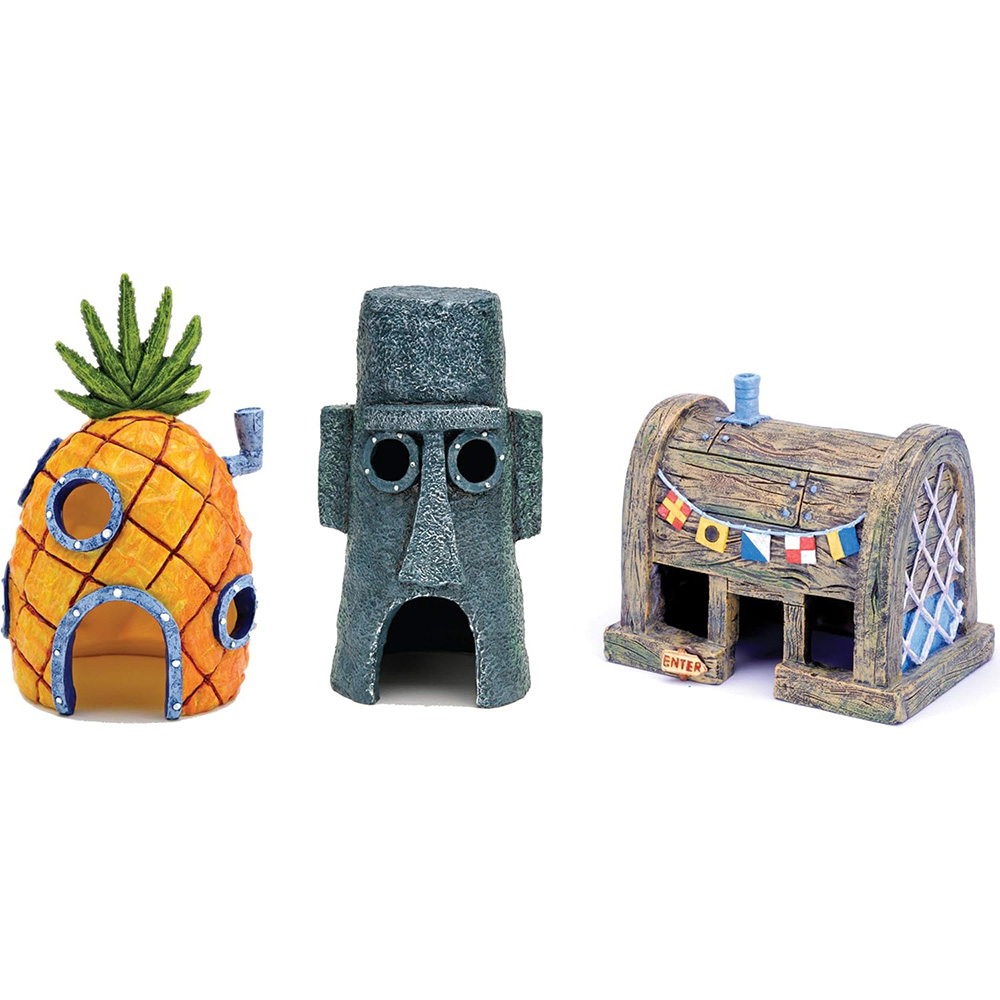
Best overall fish tank decorations
There’s a lot of enjoyment to be had in keeping fish so it’s absolutely fine to engage in some silliness. With this officially licensed Spongebob Squarepants fish tank set, you’re certainly getting a lot of the latter with an ornament bundle that includes Spongebob’s Pineapple House, Squidward’s Easter Island home and the Krusty Krab. We can’t tell if fish are going to love them over more traditional, comparative ornaments but we definitely do.
The accessories look great with fine detailing, little quirks and sizable openings and they’re great replications of the cartoon versions. They provide a variety of ways for your fish to swim through and lots of opportunities for them to hide away. And since they are made from durable resin, you can be sure that they are not only safe but will last for a good while as well – which is a good thing because the set doesn’t come cheap.
Reasons to buy: For fans of the Spongebob Squarepants cartoons, this is sure to inspire a smile.
Reasons to avoid: Although well-built and sturdy, you are effectively buying into a brand as well as an accessory.
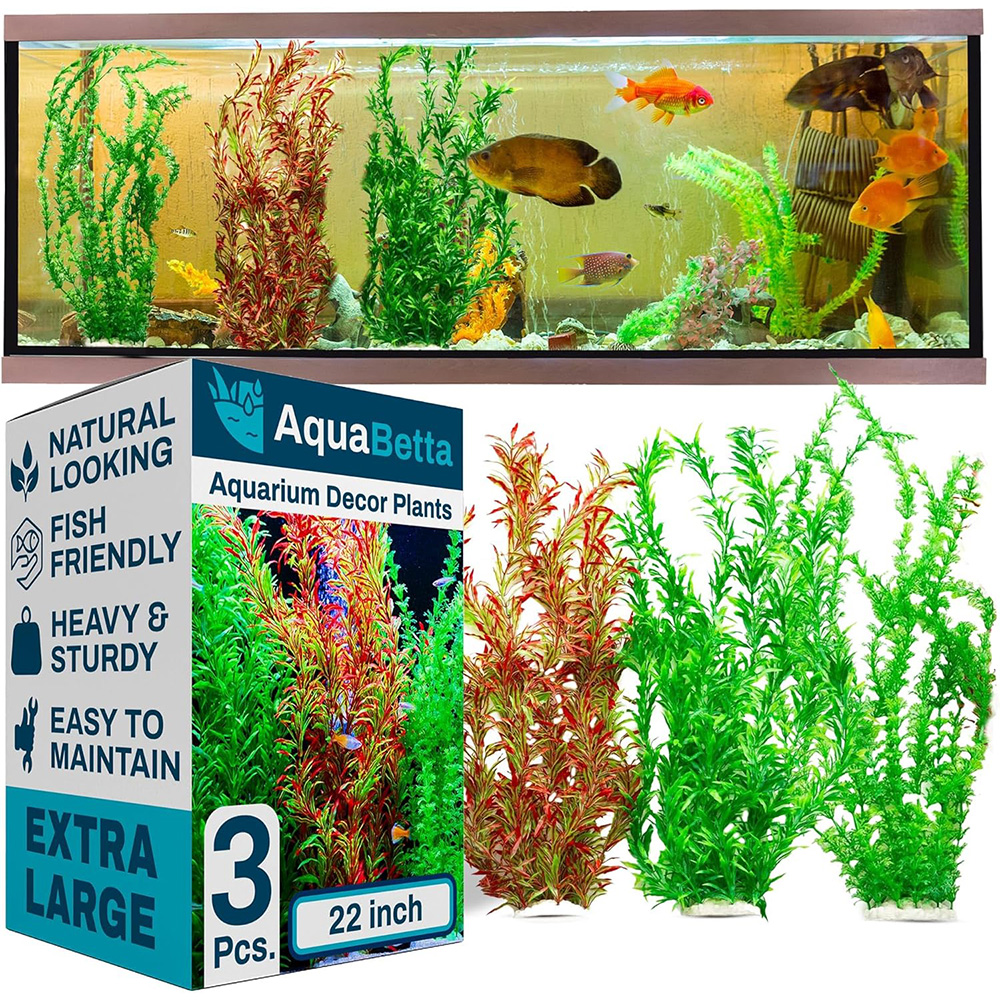
Best fish tank decorations for stimulation
This pack of three underwater plants is perfect to help fish feel more at home. Natural-looking yet artificial, they mimic plants found in the ocean or river, and they look and feel realistic when in the tank.
With an overall height of 22 inches, there is plenty of plant for fish to swim around and because they have a weighty stable base, you don’t need to worry about them toppling over in the tank. If you have a large tank, these plants would work well with other fish tank accessories such as rocks or caves. Given their size, however, we wouldn’t advise placing them in small tanks.
Just remember, the plants will require cleaning every once in a while, but they’ll be super easy to clean with warm water and a damp cloth. For the price, these three plants are great value and would make great decorations for minimalist tanks and complimentary to already decorated aquariums.
Reasons to buy: A great selection of fake aquarium plants that will make any tank look amazing.
Reasons to avoid: They are perhaps too big for all but the largest of tanks – opt for something smaller if you don’t have space.
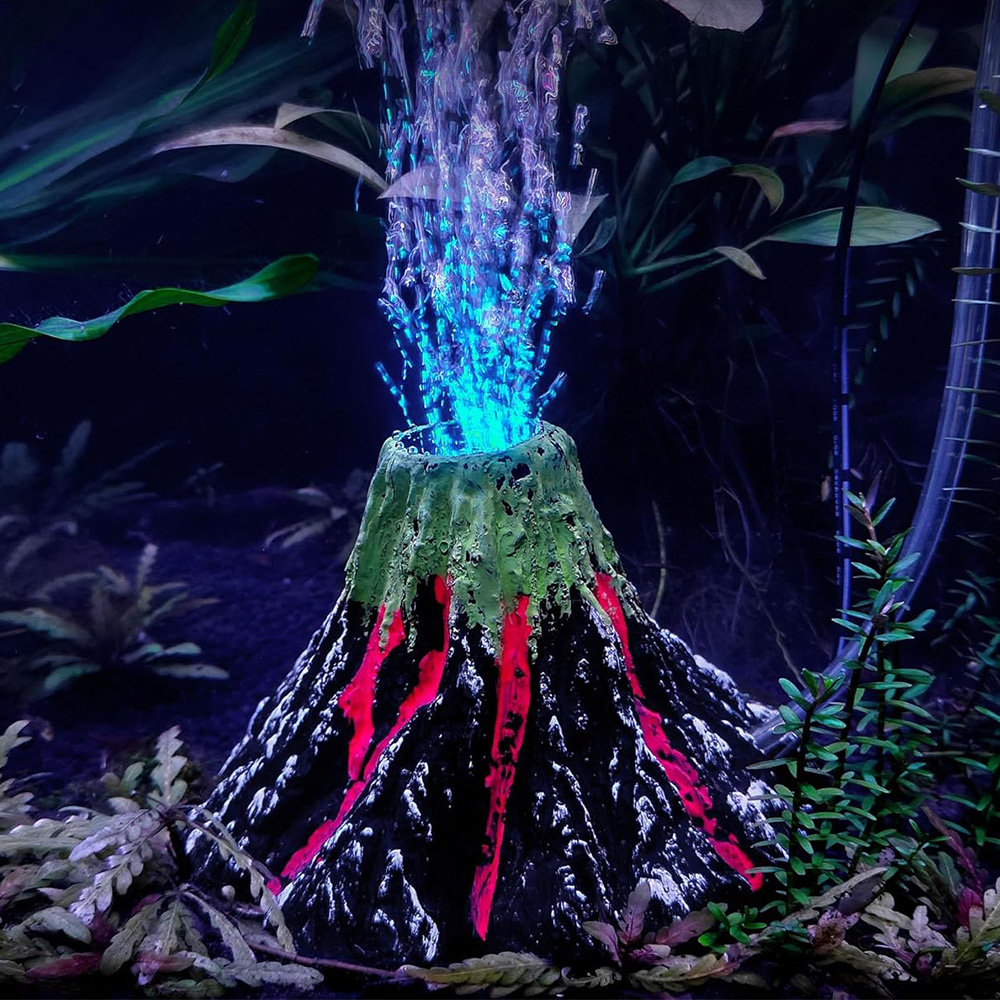
Best interactive fish tank decoration
This erupting volcano ornament is super cool and it will really light up your tank, making for a stunning showpiece. Since the ornament is connected to LED lights, a tube and an air pump, it creates an eye-catching eruption effect while being absolutely safe for your fish.
Roughly the size of a can of Coca-Cola, it may not be entirely suitable for smaller tanks, particularly if you have other ornaments in there. But not only does it look pretty in suitable tanks, it works to oxygenate the water too, keeping the tank clean and your fish happy and healthy.
As the bubbles fire out from the top, the water will circulate better but bear in mind that the product doesn’t actually come with the air pump you need. One can be easily purchased or you may even have one already but, despite being really easy to set up, this is not a product that’s ready out-of-the-box.
Reasons to buy: A beautiful erupting volcano with lit-up “lava” that also oxygenates the tank’s water.
Reasons to avoid: It won’t work well in cramped tanks and you need to buy an air pump.
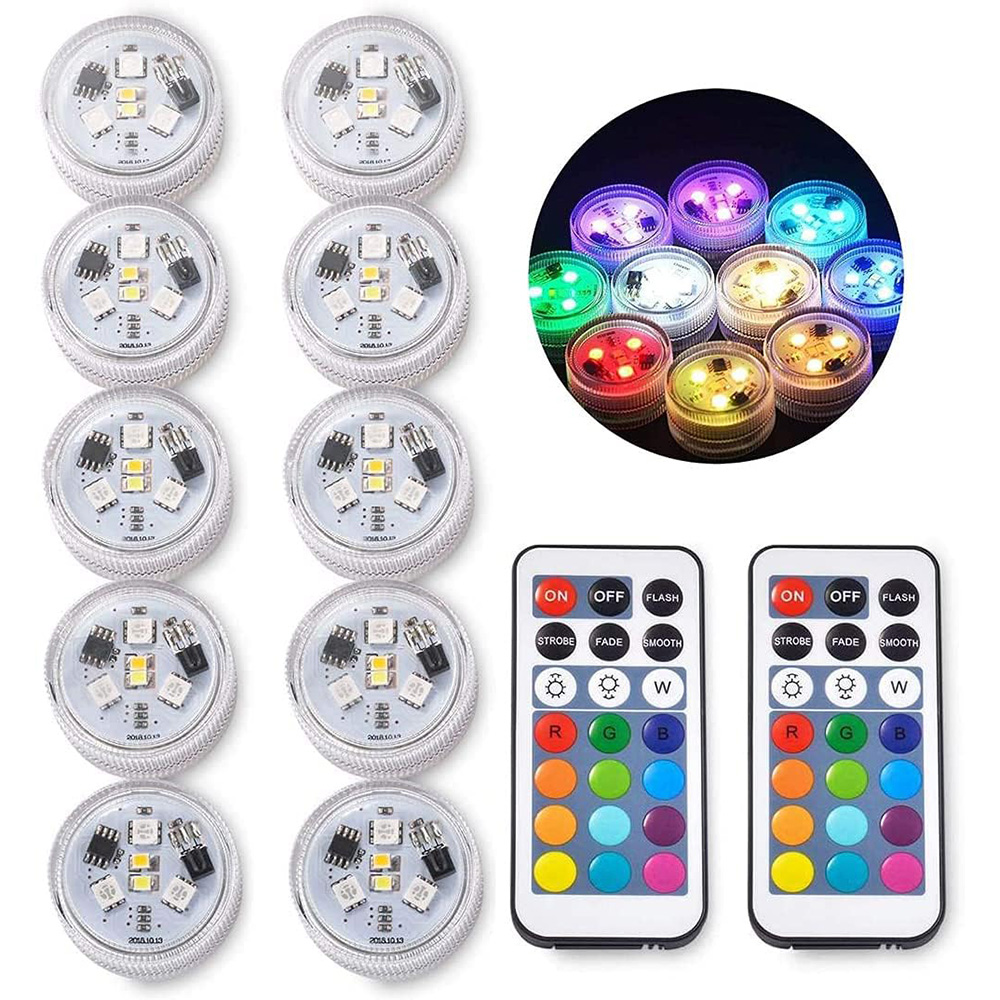
Best fish tank lights for decoration
This set of ten underwater LED lights are great for brightening up a fish tank, and they come with a remote control that allows you to set them to a variety of different colors depending on your mood. You can also determine their brightness and speed using a remote control unit which includes options for flash, strobe, fade and smooth effects. Not all of those effects will be suitable for your fish however, so common sense is advised.
Even so, the lights are super bright and they come with batteries already included. It is claimed these can last for up to 36 hours of constant use before being replaced. You can also either control every light at once or individually, allowing you to be creative. You may need to be relatively close to the tank in order to control them, though.
Reasons to buy: Great value for money lights that can complement other fish tank decorations to finish off a fun underwater look.
Reasons to avoid: Although you get a relatively lengthy battery life, you will still find yourself frequently replacing the batteries.
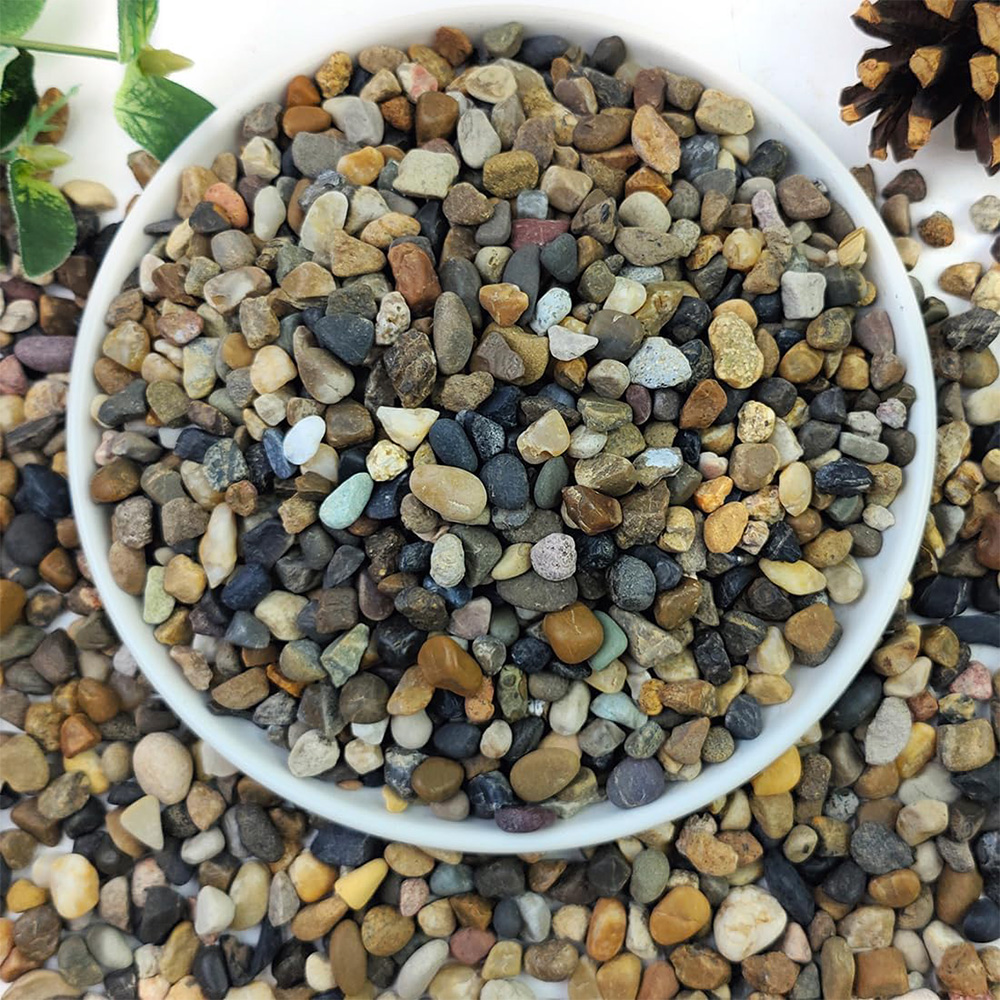
Best functional fish tank decoration
Gravel is one of the first fish tank accessories you’ll need when setting up a new tank. It is not just aesthetically pleasing but it serves an important function in keeping the tank clean. It can stop bacteria from harbouring, meaning you won’t need to clean the tank as much as if you leave the bottom clear.
This gravel is dark and stone coloured, giving it a natural feel and leaving small tanks looking light and airy. These stones are also a great addition to a tank with lots of ornaments, as it makes for the perfect ground to bury and secure other fish tank accessories, making plants look much more natural to the fish.
These small stones won’t leak colour and they won’t affect your water’s pH, so they’re a safe addition to any tank. You can use these in cold water, tropical and marine fish tanks to build a safe home for your fish.
Reasons to buy: Non-toxic, totally safe and available in different sized bags, these decorative pebbles will look great in any fish tank.
Reasons to avoid: You need to make sure that all of the stones have been properly rinsed before you place them in the tank.

Best practical fish tank accessory
It’s not exactly a fun addition to your fish tank but it sure is an important one. Stick this thermometer to the tank using the strong 3M adhesive on the rear of the device and you can make use of the backside sensor to tell you how hot or cold the water is day and night.
A simple tap on the display screen is all that is required for the large green digits to vividly and clearly display the required information. Accurate to 0.9F, you can rest assured that you’re getting a proper measurement, allowing you to take action if need be. The screen also refreshes every five seconds so temperature fluctuations will be clear.
Add a long battery life and the lack of wires and you’ve got a thermometer which should stand you in good stead for years. It’s also small enough not to get in the way of viewing your fish. What’s not to like?
Reasons to buy: A highly-accurate, easy-to-read thermometer which neatly sits outside the tank for speedy readings.
Reasons to avoid: You need to tap the screen to wake the display so it’s not great if you want to constantly monitor from afar.
How we chose the best fish tank decorations and accessories
First of all, when examining a tank accessory, we wanted to ensure that it was going to be safe – there could be no sharp edges or any potentially toxic materials. We also looked for accessories that would be practical: battery-operated items, where appropriate, that could be installed with the minimum of fuss. Given how dirty tanks can get, we sought easily cleaned decorations that wouldn’t topple too.
Why are fish decorations important?
Fish like stimulation so, just as you’re unlikely to want to live your own life in an empty room, our finned friends have a preference for intriguing habitats. As such, decorationss help fish boredom, with fish particularly enjoying items they can swim through.
“Accessories and decorations add interest and allow certain types of fish to hide meaning they can exhibit natural behaviours,” says Dr MacMillan. “Live plants will also add oxygen to your tank water as well as give certain species something to nibble on.”
While it’s great to have decorations in your tank, make sure you include them in your tank cleaning regimen. Dirt and bacteria can collect on them and can lead the to the water taking on a translucent hue. If you’ve ever wondered “why is my fish tank cloudy?”, this could be the reason.
What kinds of decorations work best?
Different sized plants, stones, wood and sand are great additions to any tank and, at the very least, you should opt for those. But, as Dr MacMillan says, there is an array of different accessories available.
“Your choice may depend on how you want your tank to look,” she says. “A natural tank will have items like bogwood, rocks, and live plants. But some owners prefer using figurines and models to create a theme, for example, a sunken pirate ship with treasure chests or gold coins.”
What colours tend to work best?
Much depends on the type of fish you have. Brightly colored fish are highlighted to perfection with accessories that are white or pale, while less-vibrant fish will look great with decorations that pack a real color-pop.
How many decorations should I have?
It’s tempting to want to buy loads of decorations and accessories but you have to remember that fish need room to swim! So don’t go overboard. Start with one or two carefully chosen accessories first and see how much space is left before investing in more.
“Whatever accessories you choose, try not to overcrowd your tank. Your fish will need plenty of circulating space to swim in, especially if they are large or a shoaling type,” Dr MacMillan affirms.

Rebecca is a vet surgeon who graduated from the Royal Veterinary College in 2009. She has a wealth of experience in first opinion small animal practice, having done a mixture of day-to-day routine work, on-call emergency duties and managerial roles over the years. She enjoys medicine in particular and she is proud to have recently achieved a BSAVA postgraduate certificate in small animal medicine (with commendation). She writes on various feline and canine topics, including behavior, nutrition, and health. Outside of work and writing she enjoys walking her own dog, spending time with her young family and baking!
Get the best advice, tips and top tech for your beloved Pets

David Crookes has been a journalist for almost 30 years and he has written for a host of magazines, newspapers, websites and books including the World of Animals Annual, BBC Earth, Live Science, The Independent and Tom’s Guide.
Born in England, he lives with two cats but he’s also keenly interested in the differences between the huge number of dog breeds – in fact, you can read many of his breed guides that he’s written in collaboration with vets here on PetsRadar.
With a lifelong passion for technology, too, he’s always on the lookout for useful devices that will allow people to keep their pets happier and healthier, and provide them more time to spend together.
David has a degree from Durham University, as well as postgraduate diploma in journalism from the University of Central Lancashire.
